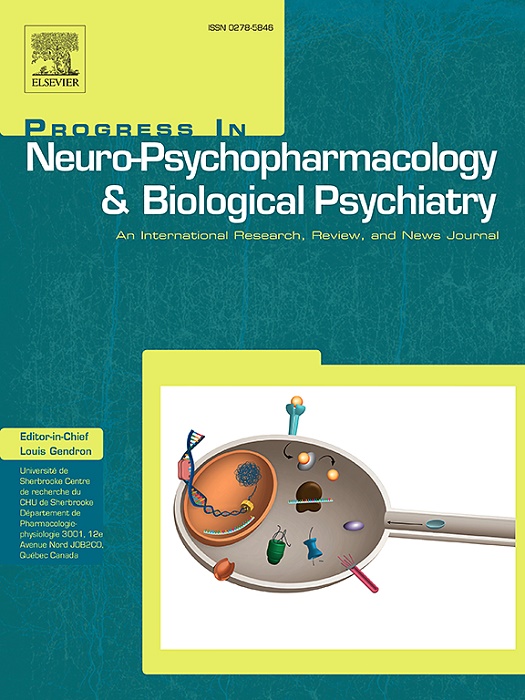Sex-specific dysregulation of the CX3CL1/CX3CR1 Axis following cocaine exposure: Translational evidence for a potential biomarker of abstinence
IF 3.9
2区 医学
Q1 CLINICAL NEUROLOGY
Progress in Neuro-Psychopharmacology & Biological Psychiatry
Pub Date : 2025-08-30
DOI:10.1016/j.pnpbp.2025.111482
引用次数: 0
Abstract
Cocaine disrupts neurotransmitter systems and promotes neuroinflammation by activating microglia and altering cytokine signaling. The CX3CL1/CX3CR1 axis is an essential signaling pathway for microglial regulation, may exhibit sex-specific responses to cocaine. In this study, male and female Wistar rats were exposed to acute (5, 15, or 30 mg/kg) or repeated (15 mg/kg/day for two weeks) cocaine. Gene expression of Cx3cl1 and Cx3cr1 was assessed in the amygdala and hippocampus, alongside plasma CX3CL1 concentrations. Additionally, plasma CX3CL1 concentrations were assessed in 88 abstinent patients with cocaine use disorder (CUD) and 30 matched healthy controls. Female rats exhibited significantly lower baseline mRNA expression of Cx3cl1 and Cx3cr1 in both brain regions compared with male rats. Acute cocaine induced dose- and time-dependent transcriptional changes, with female rats exhibiting more pronounced and sustained Cx3cl1 and Cx3cr1 expression changes compared with males. Repeated exposure produced sex-, region-, and abstinence-dependent regulations of Cx3cl1 and Cx3cr1, with persistent downregulation of Cx3cl1 and compensatory Cx3cr1 upregulation in female rats. In plasma, only male rats exhibited elevated CX3CL1 concentrations following cocaine exposure, particularly during early abstinence (i.e., 2 h–72 h). In humans, overall CX3CL1 concentrations did not differ between CUD patients and controls. However, CX3CL1 concentrations increased with abstinence duration, particularly in males (r = +0.34, p < 0.01), but not in females. These findings highlight sex-specific regulation of the CX3CL1/CX3CR1 axis in cocaine-induced neuroinflammation and suggest that plasma CX3CL1 concentrations may serve as a potential biomarker or contribute to a composite biosignature, together with other biomolecules, of CUD progression and abstinence. Considering sex differences, may enhance our understanding of addiction pathophysiology and inform targeted therapeutic strategies.

可卡因暴露后CX3CL1/CX3CR1轴的性别特异性失调:一个潜在的禁欲生物标志物的翻译证据
可卡因通过激活小胶质细胞和改变细胞因子信号,破坏神经递质系统,促进神经炎症。CX3CL1/CX3CR1轴是调节小胶质细胞的重要信号通路,可能对可卡因表现出性别特异性反应。在这项研究中,雄性和雌性Wistar大鼠暴露于急性(5、15或30 mg/kg)或重复(15 mg/kg/天,持续两周)可卡因。在杏仁核和海马中评估Cx3cl1和Cx3cr1基因表达,同时评估血浆Cx3cl1浓度。此外,还评估了88例可卡因使用障碍(CUD)戒断患者和30例匹配的健康对照者的血浆CX3CL1浓度。雌性大鼠在两个脑区Cx3cl1和Cx3cr1 mRNA的基线表达量明显低于雄性大鼠。急性可卡因诱导的剂量和时间依赖性转录变化,与雄性相比,雌性大鼠表现出更明显和持续的Cx3cl1和Cx3cr1表达变化。在雌性大鼠中,重复暴露产生了Cx3cl1和Cx3cr1的性别、区域和禁欲依赖性调控,Cx3cl1持续下调,Cx3cr1代偿上调。在血浆中,只有雄性大鼠在可卡因暴露后表现出CX3CL1浓度升高,特别是在早期戒断期间(即2 - 72小时)。在人类中,总体CX3CL1浓度在CUD患者和对照组之间没有差异。然而,CX3CL1浓度随着禁欲时间的延长而增加,尤其是在男性中(r = +0.34, p < 0.01),而在女性中则没有。这些发现强调了CX3CL1/CX3CR1轴在可卡因诱导的神经炎症中的性别特异性调节,并提示血浆CX3CL1浓度可能作为潜在的生物标志物或与其他生物分子一起促进CUD进展和戒断的复合生物标志。考虑到性别差异,可以增强我们对成瘾病理生理的理解,并为有针对性的治疗策略提供信息。
本文章由计算机程序翻译,如有差异,请以英文原文为准。
求助全文
约1分钟内获得全文
求助全文
来源期刊
CiteScore
12.00
自引率
1.80%
发文量
153
审稿时长
56 days
期刊介绍:
Progress in Neuro-Psychopharmacology & Biological Psychiatry is an international and multidisciplinary journal which aims to ensure the rapid publication of authoritative reviews and research papers dealing with experimental and clinical aspects of neuro-psychopharmacology and biological psychiatry. Issues of the journal are regularly devoted wholly in or in part to a topical subject.
Progress in Neuro-Psychopharmacology & Biological Psychiatry does not publish work on the actions of biological extracts unless the pharmacological active molecular substrate and/or specific receptor binding properties of the extract compounds are elucidated.

 求助内容:
求助内容: 应助结果提醒方式:
应助结果提醒方式:


